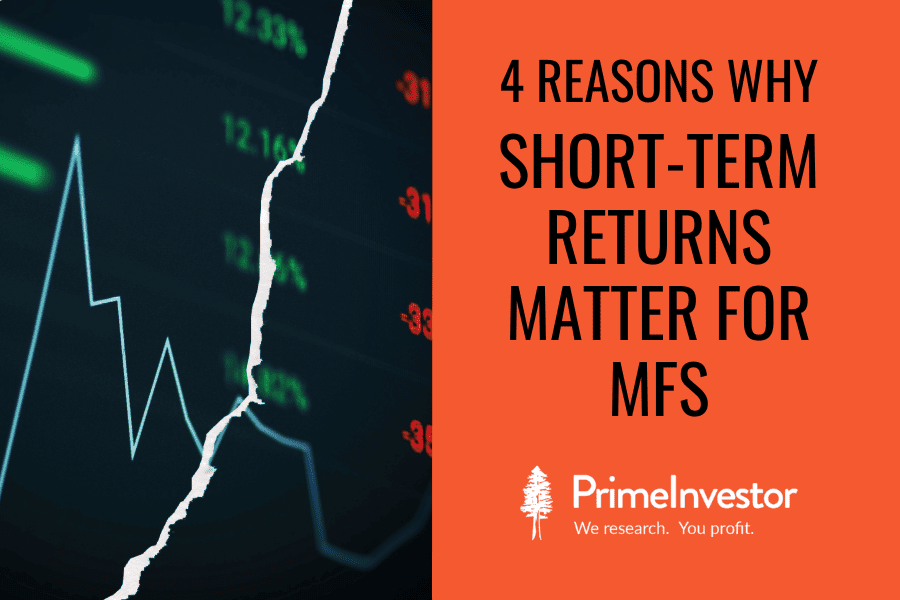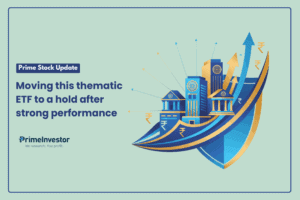Long-term is the foundation when it comes to looking at and understanding mutual fund performance. And for good reason! Long-term returns smoothen out month-to-month market performance, takes care of blips in performance that come up due to price movement of the underlying stocks or bonds a fund holds, and draws up a better picture of how the fund can deliver over your holding period.

When short-term returns matter
But for all the reasons to consider long-term returns alone, short-term returns are not entirely without merit. There are circumstances in which looking at short-term returns will enhance understanding of fund performance – and is something we consider as well, when we give our Buy/Sell/Hold calls on funds or in Prime Funds:
- When looking at shifts in fund performance
- When looking at the impact of a turn in cycles, especially for interest rate cycles in debt funds
- When looking at debt funds that have very short maturities
- When looking at potential momentum picking up or tapering off in sector or thematic funds
Here’s explaining these scenarios in detail with examples.
#1 Performance shifts
There are two ways in which fund returns can shift trends, and where short-term returns can throw more light on performance. The first is when looking at underperforming funds, or funds where returns are currently lagging their benchmark or peers in periods such as 1-year or 3 years. It is perfectly fine to be concerned over performance!
However, these funds could have otherwise been able to beat benchmarks earlier. For such funds, it would serve well to dig deeper to understand if the fund has undertaken portfolio changes or if the fund has course corrected. One way to gauge if the lag is closing is to look at very short-term returns.
Consider equity funds. There are several factors that can cause underperformance: sector calls or stock calls may have been mistimed, or these may be out of market favour, or sudden developments may have hit a few stocks in the portfolio that drags down overall returns. In such cases, the fund may have taken different steps to address the lag in returns. It could have pared holding in low-returning stocks, it could have picked up rallying stocks or sectors to shore up returns until its contrarian bets pay off, a steep stock sell-off may have slowly corrected or its impact on the fund’s return may be reducing.
All these efforts can show up in short-term periods such as rolling 3-month, 6-month or even 1-month returns. It would take a lot longer for such efforts to pay off in long-term returns, and therefore, relying on even 1-year returns alone may mean that you miss out on these performance cues.
Therefore, if you hold an underperforming fund that was otherwise a sound one in the long term, take a look at short-term returns. If you notice the gap between the index and the fund narrowing in timeframes such as 1 month, 3 months or 6 months, or you see the fund moving to a higher quartile compared to its peers, it can indicate the following – one, the fund is trying to reverse the underperformance and its efforts seem to be bearing fruit. Two, it would be prudent to wait for 1-2 more quarters to see whether this sustains and then take a call on what you should do with your investments in that fund. Remember not to look at point-to-point returns alone here – always look at trends in the returns even if it is short-term periods.
For example, let’s take Invesco India Contra which has long been part of Prime Funds. This fund had lagged the Nifty 500 index in early 2021. The 1-year returns were lower than the Nifty 500 TRI by a wide margin of 5-6 percentage points which continued in October-November 2021.
However, the shorter-term returns showed that the fund was attempting to turn performance around for the better. Going by the 6-month and even 3-month returns, the fund was reducing the margin of underperformance repeatedly throughout 2021 and shifted to outperformance by the start of 2022. That eventually sustained into 2022 and the fund was back to beating the Nifty 500 TRI by a good 2-3 percentage points by 2023. The graph below shows the movement of the 6-month and 1-year underperformance against the index in this period.
This short-term performance is among one of the reasons why we may retain funds in Prime Funds or maintain Buy calls, even if it seems like a fund is hardly at the top.
The reverse also holds. For funds that seem to be topping the charts, looking at shorter-term returns will show whether there are signs of stress. For example, in 1-year returns, Invesco India Large Cap appears to be a strong performer in the large-cap category. However, shorter-term returns show that the fund has slipped behind the Nifty 100 TRI.
#2 Impact of a turn in cycles
This holds more for debt funds than equity funds. Bond markets move in anticipation of where rates could be headed. At the inflexion points of a shift upwards or a shift to a falling cycle, fund returns are quickly impacted based on the price movements and maturity of the bonds they hold.
On the other hand, debt funds also get returns from the yield of their bonds. And this effect is especially important in a rising rate cycle. Why? When rates rise, bond prices fall. This means your fund return will turn lower. However, since your fund will also be increasingly investing in bonds bearing higher coupons, its portfolio yields go up which will eventually pull your fund returns back up. This effect will begin to first show up in short-term returns.
The past few years is a good example of the need to look at short-term returns in debt funds in certain situations. Given that we were in a prolonged low rate cycle between 2020-2022, fund returns were sub-par. The rapid hike in interest rates sent returns even lower, and the impact was keenly felt in longer-maturity funds. However, both portfolio yields and short-term returns have been improved even as returns dipped.
Consider corporate bond funds. The average portfolio yield to maturity for the category was at just 5.4% in January 2022. It moved up to 7.3% in December 2022 and now stands at about 7.6%. However, the 1-year returns for most of 2022 was less than 3%. However, if you looked at the 3 month or 6 month returns, you may have noticed the gradual improvement in returns as higher yields kicked in and the rising rate cycle impact reduced. For example, the average 6-month return had already risen to 3% by October-November 2022 and rose above 4% by April 2023. This improvement now clearly permeates into the current 7%-plus 1-year returns that most corporate bond funds sport.
In falling rate cycles too, short-term returns will show the shift in performance. When a rate cycle turns down, bond prices rise and consequently, fund returns shoot higher. This will serve as a good indicator in two ways – one, if you have adopted a duration strategy and invested in gilt funds or target maturity funds with the aim to book profits on bond price appreciation, the abnormally high short term return will tell you that this strategy is beginning to play out. It may also provide you cues to book profits.
For equity funds, you could similarly use short-term returns to identify shifts from a flat or correcting market into an uptrend, or to capture potential building up in mid-cap or small-cap market segments. However, this is not an easy trend to pin, given that equity markets in general are volatile on a month-to-month basis.
#3 Very short-maturity debt funds
Long-term returns are important when your holding period is longer and the funds themselves deliver optimally only over a few years. However, in debt fund categories where the funds’ average maturities are very short, and the ideal holding period is less than a year, looking at short-term returns is not wrong.
Overnight, liquid, ultra short, money market and low duration funds all fall in this universe. Arbitrage funds can also be included in this group, though these aren’t debt funds, since they serve a similar holding period.
For these funds, you can get an understanding of how they can deliver for you using 1-month, 3-month or 6-month returns. Further, it’s not just returns that can be analysed through the short-term lens. Other performance metrics including consistency against peers, propensity to deliver losses, maximum or minimum return, and volatility can all be measured using short-term returns.
#4 Momentum pick up in themes and sectors
If you’re not a keen market tracker, a way to identify sectors or themes that are gathering market interest is to check the very short-term returns (or forget the homework and just refer to Prime Funds for our thematic recommendations 😊). In most cases, you would notice thematic funds once their 1-year return tops the charts. In doing so, you probably missed a good part of the theme’s upswing!
Instead, if you were to look at the 1-month or 3-month returns, you’d notice higher returns much earlier. A steady uptick in these short-term returns is a good indicator that markets are showing interest in that sector. You need to then dig deeper into the sector to decide whether or not it holds promise; remember that high short-term returns alone are not reason enough to pick up thematic funds.
It is true that waiting for returns to show – even in the short term - does mean you miss the real bottom in the theme. Even so, you will still be able to catch the theme early on in the cycle and not towards the end as you may otherwise do if you watch only the 1/3/5 year returns. In any case, not many of us have the wherewithal to track a variety of sectors, so this is the next best option!
And a final bonus fifth scenario! Short-term returns are also useful to check a fund’s volatility. Running standard deviation checks of very long-term returns of 3 years or 5 years will not tell you much since volatility smoothens out over the long term. For equity funds, aggressive hybrid funds, and long-maturity debt funds, volatility in 1-year returns is a good metric. For debt funds and other hybrid funds, periods such as 1 month, 3 months or 6 months would work well when looking at volatility.
Where to go for returns
The next question, of course, is where you can find such return figures or look for such trends. Trust us to give it to you! To check trends in short-term returns, and compare to index or peer funds, our mutual fund rolling return calculator and rolling return vs category calculator are great tools. To look at aspects such as consistency, volatility, max/min returns, our MF Screener has a wealth of information.





